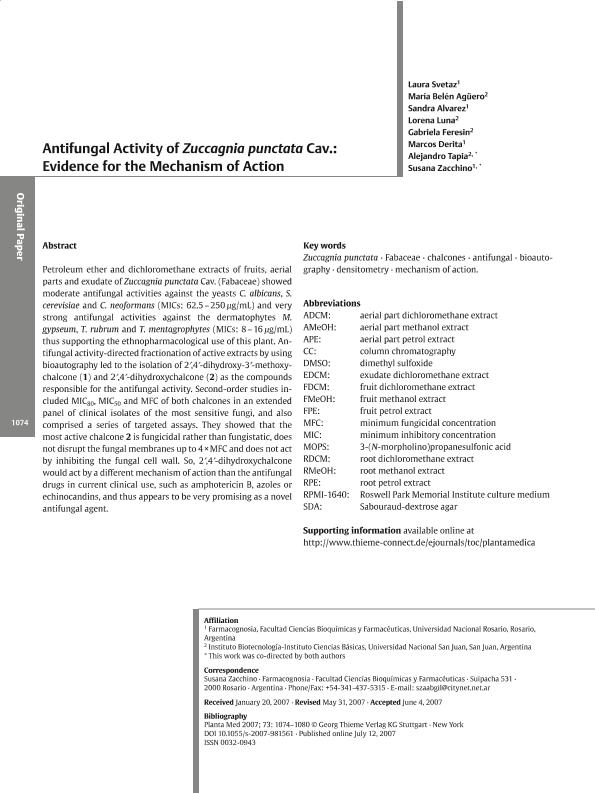Artículo
Antifungal activity of Zuccagnia punctata Cav.: Evidence for the mechanism of action
Svetaz, Laura Andrea ; Agüero, María Belén
; Agüero, María Belén ; Alvarez, Sandra; Luna, Lorena Celina
; Alvarez, Sandra; Luna, Lorena Celina ; Feresin, Gabriela Egly
; Feresin, Gabriela Egly ; Derita, Marcos Gabriel
; Derita, Marcos Gabriel ; Tapia, Alejandro; Zacchino, Susana Alicia Stella
; Tapia, Alejandro; Zacchino, Susana Alicia Stella
 ; Agüero, María Belén
; Agüero, María Belén ; Alvarez, Sandra; Luna, Lorena Celina
; Alvarez, Sandra; Luna, Lorena Celina ; Feresin, Gabriela Egly
; Feresin, Gabriela Egly ; Derita, Marcos Gabriel
; Derita, Marcos Gabriel ; Tapia, Alejandro; Zacchino, Susana Alicia Stella
; Tapia, Alejandro; Zacchino, Susana Alicia Stella
Fecha de publicación:
08/2007
Editorial:
Georg Thieme Verlag Kg
Revista:
Planta Medica
ISSN:
0032-0943
Idioma:
Inglés
Tipo de recurso:
Artículo publicado
Clasificación temática:
Resumen
Petroleum ether and dichloromethane extracts of fruits, aerial parts and exudate of Zuccagnia punctata Cav. (Fabaceae) showed moderate antifungal activities against the yeasts C. albicans, S. cerevisiae and C. neoformans (MICs: 62.5-250 μg/mL) and very strong antifungal activities against the dermatophytes M. gypseum, T. rubrum and T. mentagrophytes (MICs: 8-16 μg/mL) thus supporting the ethnopharmacological use of this plant. Antifungal activity-directed fractionation of active extracts by using bioautography led to the isolation of 2′,4′-dihydroxy-3′-methoxychalcone (1) and 2′,4′-dihydroxychalcone (2) as the compounds responsible for the antifungal activity. Second-order studies included MIC80, MIC 50 and MFC of both chalcones in an extended panel of clinical isolates of the most sensitive fungi, and also comprised a series of targeted assays. They showed that the most active chalcone 2 is fungicidal rather than fungistatic, does not disrupt the fungal membranes up to 4 x MFC and does not act by inhibiting the fungal cell wall. So, 2′,4′-dihydroxychalcone would act by a different mechanism of action than the antifungal drugs in current clinical use, such as amphotericin B, azoles or echinocandins, and thus appears to be very promising as a novel antifungal agent. © Georg Thieme Verlag KG Stuttgart.
Archivos asociados
Licencia
Identificadores
Colecciones
Articulos(INQUINOA)
Articulos de INST.DE QUIMICA DEL NOROESTE
Articulos de INST.DE QUIMICA DEL NOROESTE
Citación
Svetaz, Laura Andrea; Agüero, María Belén; Alvarez, Sandra; Luna, Lorena Celina; Feresin, Gabriela Egly; et al.; Antifungal activity of Zuccagnia punctata Cav.: Evidence for the mechanism of action; Georg Thieme Verlag Kg; Planta Medica; 73; 10; 8-2007; 1074-1080
Compartir
Altmétricas



